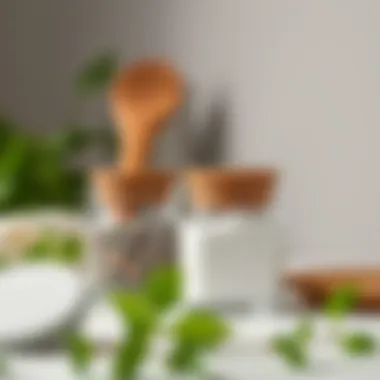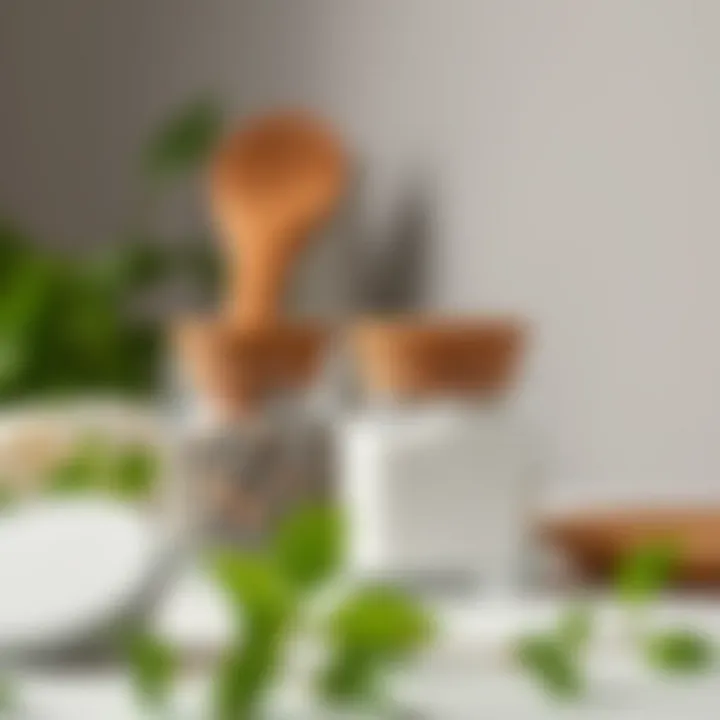The Rich Heritage and Design of Salt and Pepper Jars


Intro
When you step into a kitchen, whether it be a cozy family space or a high-end culinary haven, your eyes may naturally drift to the salt and pepper jars gracing the countertop. These seemingly simple containers hold a much deeper significanace in the landscape of culinary accoutrements. From their long history in human civilization to their role in modern design, salt and pepper jars reflect our values, aesthetics, and even our taste preferences. Today, we embark on a journey to unpack the layers of meaning and form these jars encompass.
The historical evolution of these jars tells a fascinating tale. Salt has played a crucial role in preservation and flavoring since ancient times, while pepper, once considered a commodity more valuable than gold, has an equally compelling backstory. As we navigate through their aesthetic choices and material variations, we also face the impact of contemporary trends that emphasize sustainability and innovative design.
For homeowners, designers, retailers, and enthusiasts alike, understanding these nuances can elevate not just the look of a kitchen, but its entire cultural resonance. So let’s dive into the world of salt and pepper jars, exploring both practical insights and inspiring perspectives.
Foreword to Salt and Pepper Jars
The concept of salt and pepper jars transcends mere functionality; they are the humble titans of culinary expression. In this article, we spotlight these kitchen staples that wield a surprising amount of influence over our dining experiences. You might think of salt and pepper as just that—seasoning. Yet, they can be devices for personal expression, conversation starters, and even cultural symbols.
While most kitchens boast some version of these jars, their importance stretches far beyond the everyday task of seasoning food. They reflect individual tastes, can signal a host's style, and sometimes even a whole culture's history. Imagine a gathering where the eye-catching handcrafted salt cellar steals the show, igniting discussions regarding artisanal craftsmanship while elevating the meal experience. This spotlight on salt and pepper jars leads us to consider a plethora of styles, materials, and designs that resonate on both aesthetic and practical levels.
In addition to their aesthetic appeal, these jars also play an integral role in the culinary arts. The right salt can enhance flavors that may otherwise go unnoticed, while freshly ground pepper can invigorate a dish. Choosing the right vessel is essential—not just for cooking but also for the overall ambiance of a meal. Whether you find comfort in classic ceramic designs or lean towards sleek glass options, your choice is a silent yet profound commentary on your culinary ethos.
The design landscape is rich and varied; therefore, our exploration will discuss these nuances in depth. By understanding the significance behind different designs and materials, you will acquire the tools necessary for selecting the perfect salt and pepper jars that blend seamlessly into your kitchen space or dining table.
"Salt and pepper may seem simple, but they carry the weight of history, culture, and identity every time they grace a table."
The next section will take us through an exploration of their historical roots—where they came from, how they've evolved, and what this historical context means to today’s culinary practices. In uncovering their story, we will better appreciate these unassuming yet pivotal elements of our dining experiences.
Historical Significance
The historical significance of salt and pepper jars extends far beyond simple kitchen essentials; they symbolize culinary evolution, cultural exchange, and the passage of time. These jars have not only served as practical items for the dispensation of flavor but also as artifacts that reflect societal changes and advancements in craftsmanship. As we delve into this topic, it's crucial to understand how these items transitioned from basic utilitarian tools to cherished decorative pieces in homes around the world.
Origins of Salt and Pepper Containers
Salt and pepper containers have their roots embedded in ancient civilizations. Originally, salt was a precious commodity, regarded as essential for preserving food and enhancing flavors. The earliest known usage of salt containers can be traced back to the Egyptians, who utilized clay vessels to store salt, valued both for its culinary application and its role in mummification processes. The concept of flavoring food with pepper is believed to have emerged later, with the spice trade introducing exotic flavors to different cultures.
As the centuries passed, the jars evolved into intricate forms crafted from materials like glass, metal, and ceramics. The Renaissance period, specifically the 16th and 17th centuries, marked a significant turning point. During this time, decorative designs began to flourish, as artisans crafted salt and pepper shakers adorned with intricate patterns and royal insignias. These items were not merely functional; they became symbols of status and sophistication in fine dining settings.
Evolution through the Ages
Over the years, the evolution of salt and pepper jars mirrors broader societal changes. The Industrial Revolution catalyzed mass production, leading to a decline in artisanal craftsmanship but also increased accessibility for the average household. Suddenly, elegant porcelain and glass containers were no longer reserved for the elite, but became commonplace on dining tables across various socio-economic classes.
In modern times, the design of these jars reflects contemporary tastes and environmental consciousness. From sleek, minimalist designs in urban apartments to whimsical, themed shakers that celebrate regional cuisines, today's salt and pepper jars cater to diverse palates. The introduction of eco-friendly materials in their construction also highlights a growing awareness of sustainability, resonating with consumers who prioritize environmental responsibility alongside aesthetic appeal.
"The journey of salt and pepper containers from ancient utility to modern artistry tells a tale of human creativity and adaptation."
The historical significance of salt and pepper jars not only resides in their physical forms but also in the stories they tell about our culinary practices and social developments. Recognizing this layered history enriches our appreciation of these everyday objects, transforming mere seasoning vessels into symbols of culture, tradition, and progress.
Useful Links:
Design and Aesthetic Considerations
When it comes to salt and pepper jars, the design and aesthetic considerations go far beyond mere functionality. These items are no longer just about holding condiments; they are essential components of home decor and serve as conversation starters at the dining table. From traditional collections that nod to heritage craftsmanship to sleek, modern variants that emphasize minimalist style, the choices in design reflect not only personal taste but also a broader cultural narrative at play.
Classic vs. Modern Designs
Classic salt and pepper jars often evoke a sense of nostalgia. These jars, typically made from materials like ceramic or glass, may showcase intricate patterns or hand-painted designs that speak volumes about the craftsmanship involved. A classic piece could feature motifs inspired by historical events or cultural symbols, acting as a bridge connecting the past to the present. Vintage designs, like those from the iconic Corning Ware or even pieces from local artisans, are often cherished items passed down through generations.
On the flip side, modern designs lean heavily on simplicity and elegance. Think of clean lines, a limited color palette, and innovative forms that challenge traditional aesthetics. For example, consider a set made of stainless steel with a brushed finish; it speaks to a contemporary vibe that appeals to many homeowners today. This contrast between classic and modern offers consumers a wealth of options tailored to their individual style, ensuring there’s something for everyone.
Key elements of classic vs. modern designs:
- Material Selection:
- Shape and Function:
- Cultural Reflection:
- Classic: Ceramics, porcelain, glass with ornate detailing.
- Modern: Stainless steel, acrylic, and eco-friendly materials.
- Classic: Curvature and aesthetic flourishes dominate.
- Modern: Sharp, angular shapes that prioritize space efficiency.
- Classic: Designs inspired by history and tradition.
- Modern: Tends to reflect current trends and future-forward thinking.
Whether your kitchen leans towards a vintage charm or embraces sleek modernity, the design of salt and pepper jars can significantly influence the overall atmosphere of the dining experience.
Artisanal Creations and Customization
Artisanal salt and pepper jars have begun to carve out their niche in the broader landscape of kitchenware. These pieces are not just functional; they carry a story, often reflecting the hands that created them. Many artisans utilize traditional techniques, and materials, and even local influence to produce one-of-a-kind jars that stand out in today's market.
Customization adds an exciting layer to these artisan creations. Offering a personal touch in the form of engraved initials or customized colors allows individuals to express their identity through everyday items. It provides an opportunity for people to make these jars more than just table essentials; rather, they become unique artifacts that enhance the character of one's home.


Factors to consider in artisanal pieces:
- Craftsmanship: Each piece is often hand-made, ensuring uniqueness.
- Material Choice: Artisans might use natural, locally sourced materials that have low environmental impact.
- Cultural Significance: Local artisans may incorporate cultural symbols or traditions into the design.
- Customization Opportunities: Engraving, color selections, or even designs that match the buyer’s personal aesthetic.
In today’s world, where mass production often dominates, the charm of artisanal and customized salt and pepper jars offers a refreshing alternative that celebrates individual expression and sustainability.
Embracing design is not just about aesthetics; it's about creating a home environment that speaks to who you are.
Materials Used in Salt and Pepper Jars
In the realm of kitchenware, the choice of materials used for salt and pepper jars holds significant importance. This topic not only influences the jars' aesthetic appeal but also impacts functionality, safety, and overall user experience. Each material brings its own set of unique characteristics, advantages, and potential drawbacks. Understanding these aspects can assist homeowners, designers, retailers, and DIY enthusiasts in making informed choices when selecting these everyday items.
Ceramics and Porcelain
Ceramic and porcelain options are among the most cherished choices when it comes to salt and pepper containers. These materials lend an air of elegance and sophistication to dining tables, making them a popular choice for fine dining. They are known for their durability and ability to maintain the freshness of spices.
One of the perks of ceramics is the variety of glazes and finishes available, allowing for a broad spectrum of colors and patterns. However, attention must be paid to the quality of the ceramic; lower-grade ceramics may chip easily or absorb moisture, compromising the integrity of the spices within. Here are some aspects of ceramic and porcelain jars to consider:
- Pros:
- Cons:
- Attractive designs and colors
- Good heat retention
- Smooth surfaces that make cleaning easy
- Can be brittle if dropped
- Some may contain lead-based glazes, posing potential health risks
Glass Variants
Glass salt and pepper jars present a stark contrast to ceramic options. They offer a contemporary aesthetic while allowing you to visibly monitor the contents. You can easily tell when the jar is running low on salt or pepper, which can be an advantage during meal prep. Moreover, glass does not absorb flavors or odors, making it a safe choice for spice storage.
However, one must consider that certain types of glass can be prone to breaking. Investing in tempered or thick-walled glass can mitigate this risk. Glass variants come in various designs—some boast intricate etchings, while others feature sleek, minimalist lines. The following points highlight their characteristics:
- Pros:
- Cons:
- No chemical reactions with contents
- Dishwasher safe for easy cleaning
- Stylish appearance in a wide range of designs
- Fragility can be an issue
- Often more expensive than ceramic options
Wood and Metal Options
Wood and metal salt and pepper jars cater to those looking for a rustic or industrial look. Wooden jars can bring warmth to the table setting and are often crafted from materials like bamboo or teak. These woods are not only aesthetically pleasing but also tough against wear and tear. Yet, care should be taken not to soak the wood in water as it can warp over time. Here are some details to keep in mind:
- Pros:
- Cons:
- Eco-friendly options available if sourced responsibly
- Unique, handcrafted designs, each with individual character
- Lightweight compared to glass or ceramics
- Porous nature can absorb flavors, affecting freshness
- Need regular oiling to maintain appearance and integrity
Metal jars, particularly those made from stainless steel, offer sleek designs that serve both practical and aesthetic purposes. They tend to be durable and resistant to rust, but be wary of the potential for scratches or dents over time.
- Pros:
- Cons:
- Durable and resistant to corrosion
- Stylish choices with modern appeal
- Often combined with unique dispensing mechanisms
- Can react with certain spices if not treated properly
- May require special cleaning to maintain shine
Functional Aspects
When it comes to salt and pepper jars, their function goes beyond just holding condiments. It’s about enhancing the culinary experience while also considering practical elements like usability and accessibility. In this section, we take a closer look at the importance of functional aspects and how they interplay with daily cooking and dining.
Choosing the Right Size and Shape
Selecting the right size and shape for salt and pepper jars can impact everything from kitchen ergonomics to the flavors that land on your plate. Larger jars can hold more seasoning, which is great for avid cooks who frequently use salt and pepper. Consider the shape too; a wider jar may be easier to access, while a tall one could save space in a crowded cabinet.
- Practical Sizes: Common sizes range from small, individual jars for personal use to larger ones designed for cooking. It's essential to consider how often you use these jars and how much seasoning you typically need at any given time.
- Shapes for Function: Round jars are classic and often easier to grasp, whereas square ones can fit neatly on shelves, creating better space management.
In essence, choosing wisely means blending functionality with your kitchen's decor. A well-chosen jar will not only serve your cooking needs but also contribute to your kitchen aesthetic.
Mechanisms and Dispersion Methods
The way salt and pepper are dispensed can significantly affect flavor control and user experience. There are several mechanisms available that cater to different styling preferences and convenience levels.
- Manual Shakers: The classic salt and pepper shaker has a simple mechanism that adjusts the hole size on top, allowing for varied dispersal. These are straightforward, making them a favored choice among many home cooks.
- Grinders: For those who value flavor, grinders are the unbeatable champions. They release essential oils and flavor compounds better than pre-ground spices. Fine, medium, or coarse settings allow users significant control over their seasoning.
- Pour Spouts: These can be particularly useful for larger jars where pouring directly can be riddled with mess. A well-designed pour spout ensures that the right amount comes out without cluttering the table.
Various dispersion methods highlight different aesthetic elements as well. A sleek grinder can look excellent on a dining table, while traditional shakers can evoke nostalgia.


Cultural Influences
Cultural influences play a pivotal role in the design and usage of salt and pepper jars, shaping them into more than mere kitchen accessories. These jars are emblematic of the broader culinary traditions and values of different societies. Each culture has unique preferences that reflect its history, social customs, and even geographical nuances. It’s fascinating how something as simple as seasoning can have such deep roots in identity and tradition.
Regional Preferences in Design
When we examine salt and pepper jars from various regions, one can readily notice how the local aesthetics and materials shape their forms. For instance, in Japan, you might encounter delicate ceramic jars that are often hand-painted with intricate designs. Such craftsmanship is not just art; it speaks to a cultural appreciation for beauty and attention to detail. Conversely, a typical Italian kitchen might boast wooden containers, often rustic and unrefined, symbolizing simplicity and a connection to the earth. This aligns well with the Italian ethos of celebrating natural ingredients and traditional cooking methods.
Different regions also have specific shapes and features that cater to their culinary habits. For example:
- Nordic countries emphasize minimalism; hence, you might see sleek glass designs that are more functional than ornate.
- In Latin America, bold colors and vibrant patterns are often the norm, reflecting the spirited cultures and festive surroundings there.
These choices are not merely aesthetic but are also influenced by what is locally available. Cultural significance and tradition dictate not just how these jars look, but also how they are used in everyday life.
Culinary Traditions and Their Impact
Salt and pepper, the dynamic duo of seasoning, carry with them the stories of culinary practices handed down through generations. In many Western countries, these two spices are almost always staples on the dining table, signifying a particular way of cooking and harmonizing flavors. In contrast, in Asian cuisines, it is not uncommon to find more exotic spices brought forth in embellished jars, reflecting the diverse range of seasonings that accompany their dishes.
Culinary traditions dictate not only the usage but the design of the jars as well. For instance:
- In Middle Eastern cultures, you may come across salt and pepper jars embellished with artistic engravings, utilized for both function and presentation during gatherings.
- In contrast, American barbecues might display oversized jars that are easy for guests to use while grilling, emphasizing the casual, communal dining experience.
The presentation of flavors has its own essence and embodies the cultural practices of the people using them. Using specific jars often enhances the dining experience, as they draw attention and convey a message about the food and its origins.
The intertwining of culture and culinary heritage illustrates how deeply ingrained these simple jars are within our living environments. As they seamlessly blend design with purpose, they serve not only as vessels for seasoning but also as symbols of our cultural identities and history.
The Role of Salt and Pepper Jars in Hospitality
In the realm of gastronomy and the art of entertaining, salt and pepper jars are more than mere containers; they are essential components of the dining experience. The tactile act of seasoning food not only enhances flavor but also communicates a level of care and attention the host pays to their guests’ enjoyment. Salt and pepper jars, placed strategically on the dining table, represent an invitation for guests to personalize their meals, supporting culinary expression, and elevating the entire atmosphere of hospitality.
Essential Elements for Dining Sets
Every detail matters when setting a dining table, and salt and pepper jars are fundamental elements that contribute to the overall aesthetic and functionality. In fine dining contexts, aesthetically pleasing salt and pepper jars can act as conversation starters, often crafted with intricate designs or unique materials that catch the eye. Here are some key aspects to consider when integrating these jars into dining sets:
- Harmony with Tableware: Salt and pepper jars should complement the overall style of the dinnerware. Whether the setting is rustic, modern, or traditional, the color and design of these jars should blend in or provide a striking contrast.
- Accessibility: Guests should easily access the jars without hassle. This consideration not only enhances the dining experience but also demonstrates thoughtful hosting.
- Proportions: The size of the jars should be proportionate to other elements on the table. Oversized jars can look out of place on a compact table, while tiny jars may get lost in a larger setting.
- Refillability: Opting for jars that can be easily refilled assures that the dining experience remains uninterrupted. This is especially crucial in extended meals or gatherings.
Presentation and Table Aesthetics
Presentation counts, and salt and pepper jars play an important role in setting the visual tone of a table. Here, the aesthetic properties of these jars come into play significantly. A few pointers to consider are:
- Color Coordination: Utilizing jars that align with seasonal colors can enhance the dining experience. For instance, earth-tone jars may add warmth during autumn gatherings while brighter, pastel hues can evoke the freshness of spring.
- Creative Arrangements: Instead of standard placements, consider displaying jars on a small pedestal or on a decorative tray with other condiments. This can create a focal point on the table.
- Quirky Designs: Selecting salt and pepper jars with unusual shapes or vibrant themes can effectively inject personality into the dining atmosphere. Think about kitschy designs that might spark laughter or engaging conversations among guests.
- Use of Natural Elements: Pairing jars with natural materials like wood or stone—such as a wooden cutting board under the jars—can enhance the table’s organic aesthetic.
When guests feel that attention has been paid to even the simplest items, like salt and pepper jars, it sets a tone of gratitude and respect. This subtlety can greatly influence their dining experience.
In summary, salt and pepper jars are pivotal in hospitality. They serve functional purposes, of course, but their role in enhancing table aesthetics and creating a welcoming atmosphere cannot be overstated. By choosing the right jars that resonate with the overall dining experience, hosts can not only improve flavors but also the entire ambiance, making each meal memorable.
For further guidance on incorporating these items into your dining aesthetics, resources such as Wikipedia offer a wealth of information on design choices and styles.
Sustainability and Eco-Friendliness
As the global community becomes increasingly aware of environmental issues, the conversation around sustainability extends to even the smallest items in our homes, including salt and pepper jars. The significance of eco-friendly practices in kitchenware is more than merely a trend; it’s a call to action for homeowners and designers alike to adopt materials and methods that minimize environmental impact. Understanding how these containers intertwine with sustainability encourages a more mindful approach to kitchen design.
Materials with Low Environmental Impact
When it comes to selecting materials for salt and pepper jars, opting for those with minimal environmental footprints is crucial. Here are several noteworthy options:
- Bamboo: This fast-growing grass is one of the most sustainable materials available. It's biodegradable and requires little energy to produce, making it an excellent alternative to plastic.
- Recycled Glass: Using glass that’s been recycled reduces waste and energy consumption. This choice also promotes a circular economy, where materials are used repeatedly.
- Clay: Pottery or ceramics made with local clay can be eco-friendly, especially if produced using traditional methods that don’t rely on heavy machinery.
The essential aspect of these materials lies not merely in their production but in their durability and end-of-life options. For instance, bamboo jars break down naturally, while recycled glass can be continuously reused without losing quality.
Trends in Upcycled Designs
Upcycling has taken the world by storm, and salt and pepper jars are no exception. Transforming items that would otherwise end up in the landfill into stylish and functional kitchenware reflects both creativity and sustainability. Here are some vibrant examples of how upcycled designs are reshaping the landscape of culinary containers:
- Vintage Jars: Old spice jars or even mason jars, often available at thrift stores or family attics, can become unique salt and pepper containers. Adding a bit of paint or decorative tape gives them a fresh twist while retaining their charm.
- Repurposed Metal Containers: Many people are using repurposed tin cans or metal containers, giving them a new life after their original purpose has ended. A quick coat of paint or a clever label can transform them into remarkable kitchen accents.
- Craft Projects: DIY enthusiasts are continuously creating eye-catching pieces, such as salt and pepper shakers made from corks or empty baking powder containers. These personalized designs not only reduce waste but also tell a story, connecting the owner to their kitchenware.
"Upcycling not only addresses waste but creates conversation pieces, blending functionality and art in the kitchen."
In summary, as we ponder the sustainability and eco-friendliness of our salt and pepper jars, it becomes evident that choices echo beyond the kitchen. By utilizing materials with low environmental impact and embracing upcycled designs, we take meaningful steps toward a greener future for our homes and communities. This mindful approach resonates with homeowners, designers, and enthusiasts alike, affirming that even the simplest items can make a significant difference.
Maintenance and Care
Understanding the importance of maintenance and care for salt and pepper jars is crucial. These seemingly simple kitchen items not only serve a functional purpose but also hold aesthetic and cultural significance. Proper maintenance ensures that they remain both visually appealing and fully operational. Neglecting care can lead to a diminished life span, altering the spices' quality and adversely affecting your dining experience. Maintaining these jars is a straightforward task that reaps multiple benefits, from preserving flavor integrity to enhancing the overall kitchen decor.


Cleaning Techniques for Different Materials
Cleaning methods vary depending on the material of the salt and pepper jars. Knowledge of the right technique can prevent damage and prolong their life.
- Ceramics and Porcelain:
- Glass Variants:
- Wood and Metal Options:
- Use warm water and mild dish soap. Avoid abrasive cleaners that might scratch the surface.
- For stubborn stains, mix baking soda with water to form a paste and gently rub the area.
- These are generally dishwasher safe; however, hand washing is advisable for intricate designs.
- Spray vinegar on the interior and wipe with a soft cloth to eliminate any residue.
- Wood jars require a light wipe with a damp cloth to prevent warping, followed by immediate drying.
- Metal jars may need special metal cleaners to maintain shine; a mixture of vinegar and olive oil works wonders.
Proper cleaning techniques not only help maintain aesthetics but also contribute to healthy usage.
Storage Practices for Longevity
Proper storage practices can greatly enhance the longevity of your salt and pepper jars. Here’s how you can ensure they remain in top shape:
- Location: Store your jars away from direct sunlight and heat sources to prevent fading and warping.
- Sealing Mechanism: If your jars come with a lid, ensure it seals tightly to keep moisture out. This is particularly vital for salt, as it can clump up.
- Avoid Overfilling: Keeping jars filled to the brim can make cleaning and refilling cumbersome. It’s better to keep a reasonable amount in each jar, making maintenance easier.
Trends in Salt and Pepper Jars
In the fast-evolving landscape of kitchen ware, salt and pepper jars are no exception to the waves of innovation and style. This section focused on Trends in Salt and Pepper Jars highlights their inherent significance, shedding light on modern shifts in design and consumer preferences. As homeowners, designers, and retailers all strive to create aesthetically pleasing yet functional kitchen environments, understanding these trends becomes crucial to staying relevant in the marketplace.
Current trends aren’t just about making things look pretty; they also reflect deeper societal values. A growing emphasis on sustainability, for instance, has ignited interest in eco-friendly materials. Brands are increasingly experimenting with biodegradable plastics and repurposed woods, aiming for both elegance and minimal impact on the environment. This shift not only caters to modern sensibilities but also invites thoughtful conversations about consumer choices and environmental responsibility.
Current Innovations in Design
The realm of salt and pepper jars is brimming with creativity. Today, manufacturers have moved beyond traditional designs, introducing innovative shapes and functionalities that cater to the contemporary consumer.
- Dual-Functionality: Some jars now combine salt and pepper compartments in one sleek unit, saving space in often cramped kitchen areas. These designs incorporate innovative mechanisms like magnetic closures or twist functions that allow easy access to both condiments without needing to sift through multiple containers.
- Smart Technology: We're seeing a rise in digital salt and pepper shakers that can measure out exact quantities. Some tech-savvy gadgets feature built-in scales or timers, appealing to precision-focused chefs who desire more accuracy in their culinary endeavors.
- Interactive Designs: Certain jars encourage user participation. For example, customizable labels allow homeowners to personalize the jars according to their own culinary style or favorites, transforming simple kitchen tools into charming decor pieces.
These innovations not only keep the traditional appeal alive but also elevate the everyday cooking experience, making it both functional and enjoyable.
The Influence of Social Media on Design Choices
Social media platforms are powerful influencers in the current design trends for salt and pepper jars. The ability to share photos and ideas has made visual platforms like Instagram and Pinterest vital for creatives and consumers alike.
- Aesthetic Appeal: The importance of aesthetics has soared. Social media showcases how beautifully designed jars can enhance kitchen decor, leading to a rise in artisanal and unique designs. Users often post pictures of their dining setups featuring stylish salt and pepper jars, inadvertently setting trends that manufacturers can’t ignore.
- Influencer Collaboration: Many brands partner with social media influencers to reach broader audiences. These influencers introduce products to their followers, often showcasing how these jars enhance the overall dining experience. The clout of a trusted influencer can significantly sway consumer decisions, making them an integral part of the marketing strategy.
- Hashtag Movements: Engaging hashtag campaigns draw attention to specific trends or types of jars. For instance, tagging #EcoFriendlyKitchen or #CustomSaltAndPepper can lead to a robust conversation about preferences and inspire individuals towards more sustainable or personalized options.
In this digital age, consumers no longer choose kitchenware based solely on functionality; they consider how these items fit into their broader lifestyle narrative—one that is shared with friends and followers across social media.
Personalizing Your Salt and Pepper Experience
In today's world, where individuality and personal touch reign supreme, the idea of personalizing salt and pepper jars stands out. This isn’t just about having containers for seasoning; it's an opportunity to express oneself. Personal touches can establish a conversation starter on the dining table or reflect cultural heritage through design choices. Moreover, customized jars may carry sentimental value, reminding us of cherished memories or connections.
DIY Customization Projects
Engaging in DIY customization for salt and pepper jars can be a rewarding endeavor. It allows for creativity to flow. Whether you're new to crafting or an experienced DIYer, there are multitudes of projects you might consider:
- Painted Designs: Using non-toxic paints can completely transform ordinary ceramic or glass jars into unique art pieces. Designs could range from floral patterns to geometric shapes or even personalized monograms.
- Decoupage Technique: This involves gluing printed images or designs on the jars. Sealing it with a clear coat ensures durability. Vintage prints or family photos can create a nostalgic statement.
- Etching: For those who enjoy a more hands-on skill, glass etching provides a polished effect. Utilizing etching cream and stencils can enable you to carve intricate designs compellingly.
- Fabric Covers: Simple fabric wraps tied around the jar can introduce texture and warmth. Choose fabrics that resonate with your decor theme or represent your style.
Dedicating time to craft these unique jars elevates their function from mere capacity holders to cherished keepsakes. Adding a story behind each piece enhances its presence on the table, making it more than a culinary necessity.
Gift Ideas and Collectibles
Personalized salt and pepper jars make fantastic gifts that are both practical and thoughtful. Many individuals appreciate gifts that demonstrate a degree of effort and consideration. Consider the following ideas for gifting or starting a collection:
- Custom Engraved Jars: Engraving names, initials, or even inspirational quotes on jars can make them special. It personalizes the gift while maintaining decorum.
- Themed Sets: For those with a specific hobby or interest, consider creating themed salt and pepper sets. For instance, sports enthusiasts might enjoy jars shaped like their favorite gear, while nature lovers may appreciate ones shaped like plants or animals.
- Travel Souvenirs: Collecting salt and pepper jars from various places can turn into an exciting hobby. Look for jars at local markets or on travels that capture the essence of the destination. Each jar can hold a story or memory worth sharing.
- Vintage Finds: Scouring antique shops for one-of-a-kind pieces offers a unique approach. Vintage jars can serve as excellent conversation starters, every scratch and mark tells a story.
The practice of personalizing salt and pepper jars bridges functionality with sentimentality. It's about making a statement and preserving experiences in daily life. Whether you’re enhancing your own collection or gifting to others, these jars can be harmonious reflections of taste and personality.
Culmination
In wrapping up our exploration of salt and pepper jars, it becomes evident that these everyday items bear more significance than meets the eye. They are not just vessels for spices; they encapsulate a rich history, cultural variations, and evolving designs that reflect our changing culinary landscape. Analyzing their journey from humble containers to stylish decor showcases the importance of understanding both their functionality and aesthetic appeal.
Considering the elements discussed throughout this article, one key takeaway is the dual nature of salt and pepper jars. They serve a practical role in our kitchens while simultaneously expressing personal or cultural identities. This duality fosters a connection not just to the culinary arts but also to family traditions, as many households pass down unique pieces that evoke fond memories.
Benefits of Choosing Thoughtfully
When selecting salt and pepper jars, homeowners, designers, and retailers should ponder various factors:
- Material Quality: Opting for durable materials can impact the longevity of the jars while reflecting individual style.
- Size and Shape: The right dimensions can affect usage and aesthetic; a tall jar might suit a contemporary kitchen, while a rounded one may fit better in a rustic setting.
- Cultural Relevance: Understanding the significance of designs from different regions may enhance the dining experience and improve guests’ engagement.
It’s also worth noting the sustainability aspect discussed earlier—not only is opting for eco-friendly materials a responsible choice, but it also aligns with growing consumer preferences toward environmentally conscious products. In today's market, a commitment to sustainable practices can elevate a brand’s reputation, making the salt and pepper jar a pivotal item in both form and function.
Ultimately, salt and pepper jars are more than just accessories. They reflect history, culture, and individual taste. As we incorporate these elements into our homes, we redefine the simple act of seasoning food into an opportunity to connect with our heritage and with one another.
"The kitchen is the heart of the home, and small details can make it sing."
This sentiment encapsulates the essence of salt and pepper jars—they may be small, yet they play a significant role in enhancing the culinary experience and enriching our daily lives.
For more about the history and cultural significance of kitchen items, you can visit Wikipedia or explore articles from Britannica.
As we close this chapter on salt and pepper jars, let's keep in mind their multifaceted nature, ensuring that our choices reflect both personal style and a respect for culinary heritage.















